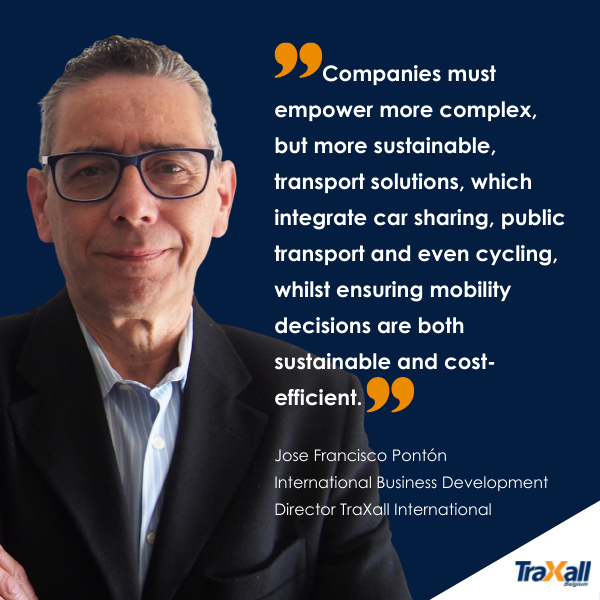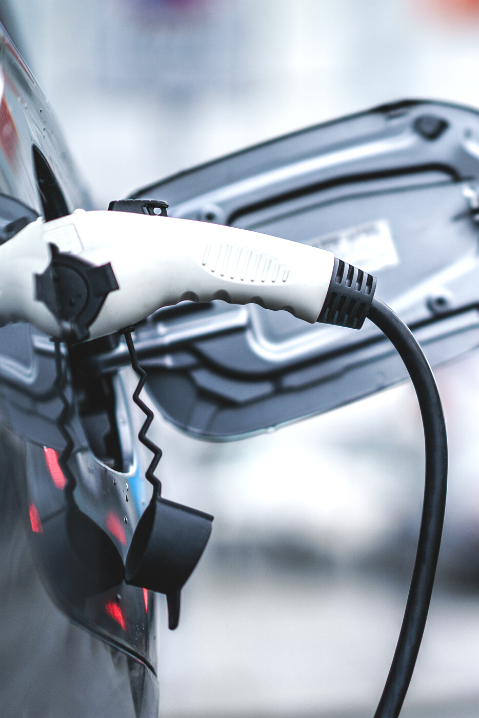With more than 21 years of fleet management experience, we caught up with Francisco Ponton, TraXall International’s newly appointed International Business Development Director, to discuss the challenges and opportunities of integrating sustainable mobility into fleet strategy.
The drive for more planet-friendly mobility
The European Commission’s Sustainable and Smart Mobility Strategy, presented in December 2020, contains an action plan to transform the EU transport system, aligned to the European Green Deal and the EU’s digital strategy.
This plan outlines actions in 10 priority areas, including boosting the uptake of zero-emission vehicles, renewable and low-carbon fuels and related infrastructure. It champions legislative and non-legislative initiatives to reduce greenhouse gas (GHG) emissions and air pollutants to promote the uptake of zero-emission vehicles and to boost innovation in vehicle technologies, especially with respect to batteries and hydrogen.
The strategy aims for at least 30 million zero-emission vehicles to be in operation across Europe by 2030 and close to 100 per cent zero-emission vehicles to be on European roads by 2050.
We asked Francisco if he feels this ambitious target is achievable.
“It will depend upon a number of different factors, including political and societal willingness, the evolution of the current supply chain crisis, material shortages and, sadly, possible crises such as war or Covid evolution,” he explained.
“What we can say is that we are clearly seeing an acceleration in the actions that will allow us to get there.”
In 2020, the average emissions from new passenger cars registered in the EU, Iceland, Norway and the UK were 107.8 grams of CO2 per km (g CO2/km), according to data published by the European Environment Agency. This is 14.5g (12 per cent) lower than in 2019, and the first decrease since 2016.
The share of electric cars in new registrations rose from about 3.5 per cent in 2019 to about 11 per cent in 2020, exceeding one million registrations for the first time. New vans registered in Europe in 2020 had average emissions of 157.7g CO2/km, 2.3g (1.5 per cent), less than in 2019, and the share of electric vans increased from 1.4 per cent in 2019 to about 2.3 per cent in 2020.
Breaking down green barriers
Ponton believes the key challenges and barriers to achieving the overall EU emissions goal will mainly come from recharging infrastructure, interoperability adoption, purchase price and product availability, along with the national and local legislative disparity between countries and territories.
He explains: “The main solutions to overcoming these challenges will come from a joint effort directed by the EU, national and local governments.
“They must increase incentives for EV adoption, to both corporates and individuals, and reduce the administrative burden by introducing simple, proactive and common legislation that transcends borders.
“Maximising investment in technological developments to improve range and recharging speed is also key to greener, cleaner and more efficient fleets.”
Integrated mobility solutions
The EU’s sustainable mobility strategy aims for all journeys under 500km to be carbon neutral by 2050.
With such an ambitious target, Ponton believes fleet operators must look at how rail travel and other modes of transport can be incorporated into single journeys.
“Companies must empower more complex, but more sustainable, transport solutions, which integrate car sharing, public transport and even cycling, whilst ensuring mobility decisions are both sustainable and cost-efficient,” he said.
“Optimal transportation will vary from country to country, depending on their road network, rail connections and the available charging infrastructure. Technology and powerful data insights, however, will undoubtedly play a pivotal role in defining the optimal mobility configuration, based on balancing cost and sustainability targets.”
Will it be a rocky road to zero?
We asked Francisco if he believes every vehicle on the road – new trucks included – will be zero-emission by 2050?
“I would love to say yes, but I honestly doubt it,” he said.
“We need to consider the huge difference across Europe in EV penetration. Countries with a low GDP per inhabitant have a very low EV penetration, which means they are already facing a difficult task to achieve this goal.
“It will take them much longer to get anywhere near those targets, unless massive funding is provided by the EU, which I can’t see happening. So, I believe that some countries will achieve the targets but sadly not all.”
Ponton agrees that that the Euro 7 emissions standard coming in 2025 should be welcomed. “It’s always positive to set ambitious standards but it’s essential to ensure that we measure real performance accurately,” he said. “I look forward to seeing the full impact of Euro 7 compared to Euro 6.”
Mobility monetary incentives
As the EU plans to offer substantial road charge discounts to zero-emission trucks across member states, we asked Francisco what impact he thinks this will have.
“I believe that if we’re serious about incentivising change, we need to act decisively and explore all available opportunities – including monetary incentives. Trucks account for around two per cent of the vehicles on the road, but they produce almost 22 per cent of the overall emissions.
“Truck operators face a far greater challenge than the typical car fleet, and that means we need to act swiftly. I am confident that if reasonable and cost-efficient solutions were made available, change would be welcomed by all EU countries. Afterall, everyone is committed to environmentally-friendly transport.
Charging ahead
Ponton believes that businesses should devise and implement a robust workplace charging strategy but accepts that implementation will depend very much on the type of fleet that each business operates.
For example, are vehicles parked at drivers’ homes or at central depots? Is it possible to recharge overnight? What is the average daily mileage and are there fixed routes? What is the availability of a reliable public recharging infrastructure?
All these factors paint a clear picture of the fleet, the driving patterns and operational reality. With this data, fleet managers should be able to plan a robust workplace charging strategy.
Quick fix measures
Francisco is confident that there are multiple short-term strategies to reduce carbon emissions if full transition to an EV fleet is not immediately possible.
“New ICE vehicle models continue to reduce their CO2 emissions and operators can adapt their fleet and company car catalogues towards models with low emissions,” he said.
“They also have the option of PHEV which should, if used efficiently, also guarantee a significant reduction in CO2, and don’t forget that opting for hybrid models can serve as a bridge until full electrification is possible.”
Streets ahead in sustainable transport
We asked Francisco which countries he feels are leading the way in sustainable mobility and where fleet businesses are proving the most proactive and innovative.
He replied: “It’s no secret that within Europe, the Nordic countries are leading in sustainable transport, if measured by share of electric vehicles or overall CO2 emissions per car. They have a far higher penetration of EVs within their overall vehicle park.
“Nevertheless, we’ve seen how countries like The Netherlands, Germany, the UK and France have accelerated the building of an infrastructure that will allow for rapid electrification development – and this is reflected in their robust EV sales figures. This is a general trend across Europe, but there are still several countries lagging behind and there is an urgent need for them to catch up.”
Crossing the border challenge
To conclude, Ponton shared his thoughts on the specific green challenges posed for cross border fleets, operating across multiple countries.
“The challenges that spring to mind are related to the different legislation in the different countries of operation,” he said.
“Although we have EU legislation that provides a common legal umbrella, the transposition to national law always brings local nuances that can prove challenging. Similarly, anti-pollution rules vary widely depending on the country, region or city.”
The final word
Francisco is committed to expanding TraXall International’s presence in the green crusade across global markets and consolidating the company’s leading position as an innovator in sustainable mobility solutions.
“Businesses are increasingly looking for more planet-friendly approaches to fleet management and I am passionate about sharing that journey.”
Download this interview


